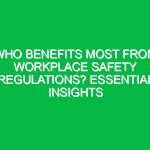Introduction
Understanding which agency enforces food Safety in a restaurant is crucial for anyone involved in the food service industry. Food Safety is a vital component of public health, ensuring that the food served is safe for consumption and free from contamination. In the Health, Safety, and Environment (HSE) domain, the enforcement of food safety Standards is paramount. This article delves into the various roles and responsibilities of the agency tasked with enforcing food safety in restaurants, while also exploring the regulatory framework and the Best Practices for maintaining a safe dining environment.
Who Enforces Food Safety in Restaurants?
In the United States, the primary agency that enforces food safety in restaurants is the Food and Drug Administration (FDA). The FDA is responsible for ensuring that food products are safe, sanitary, and labeled according to Regulations. However, it is important to note that local and state health departments also play a critical role in monitoring food safety practices in restaurants. These agencies implement the FDA’s guidelines and conduct inspections to ensure compliance.
The FDA’s Food Code serves as a model for state and local jurisdictions to develop their own food safety regulations. This code includes guidelines for food handling, preparation, storage, and sanitation practices. It is essential for restaurant owners and managers to be familiar with these regulations, as they directly impact their operations and the safety of their patrons.
The Role of Local Health Departments
Local health departments are the frontline enforcers of food safety regulations. They conduct inspections, investigate foodborne illness outbreaks, and provide Training and resources to restaurant staff. Each state has its own health department, and these agencies tailor their regulations based on the FDA’s Food Code while also considering local conditions and needs.
During inspections, health department officials assess various factors, including:
- Food storage temperatures
- Sanitation practices
- Employee hygiene
- Contamination risks
- Proper food handling techniques
These inspections help identify potential Hazards and ensure that restaurants maintain a safe environment for food preparation and service. Establishments that fail to meet the required standards may face penalties, including fines, mandated training sessions, or even closure until compliance is achieved.
Understanding Food Safety Regulations
Food safety regulations are a combination of federal, state, and local laws designed to protect public health. The FDA sets the national standards, but each state can modify these regulations according to local needs. Understanding these regulations is crucial for restaurant owners and managers to ensure compliance and avoid legal repercussions.
Some key regulations include:
- Food Safety Modernization Act (FSMA): This act emphasizes Prevention over response to food safety incidents.
- ServSafe® Certification: A widely recognized food safety training program that covers essential food safety practices.
- Hazard Analysis Critical Control Point (HACCP): A systematic approach to food safety that focuses on identifying and controlling potential Hazards.
Compliance with these regulations not only protects customers but also enhances the restaurant’s reputation, leading to increased business and customer trust.
Best Practices for Food Safety in Restaurants
Implementing Best Practices in food safety is essential for any restaurant aiming to provide a safe dining experience. Here are some actionable insights:
1. Employee Training and Hygiene
Training staff on proper food handling techniques is critical. Regular workshops and refreshers on hygiene practices, such as proper handwashing, can significantly reduce the risk of contamination.
2. Temperature Control
Maintaining proper temperatures for food storage is vital. The “danger zone” for food is between 40°F and 140°F, where bacteria can grow rapidly. Use thermometers to regularly check temperatures and ensure food is stored correctly.
3. Cleaning and Sanitation
Regular cleaning schedules should be established. Surfaces should be sanitized frequently, and equipment should be properly maintained. A clean environment not only adheres to regulations but also makes for a more pleasant dining experience.
4. Proper Food Storage
Food should be stored in airtight containers and labeled with dates to prevent spoilage. Implementing a First In, First Out (FIFO) system helps ensure that older products are used before newer ones.
5. Regular Inspections and Audits
Aside from mandatory inspections by health departments, conducting internal audits can help identify areas of improvement. This proactive approach fosters a culture of safety and compliance.
Real-Life Examples of Food Safety Enforcement
Examining real-life scenarios can provide valuable insights into the importance of enforcing food safety regulations. For instance, in 2015, a popular restaurant chain faced heavy backlash after a widespread outbreak of foodborne illness linked to contaminated produce. Investigations revealed inadequate training and a lack of adherence to basic food safety protocols. This incident not only harmed the restaurant’s reputation but also led to significant financial losses and legal repercussions.
On the flip side, consider a small family-run diner that prioritized food safety by implementing rigorous training programs and maintaining a spotless kitchen. They consistently received high ratings from health inspectors, which translated into loyal customers and positive word-of-mouth referrals.
Potential Hazards and Risks
In the context of food safety, various hazards can threaten the safety of food served in restaurants. These can be categorized into three main types:
- Bacterial Hazards: Common bacteria like Salmonella, E. coli, and Listeria can contaminate food and cause serious health issues.
- Chemical Hazards: These include improper use of cleaning agents or pesticides that can leave harmful residues on food.
- Physical Hazards: Foreign objects such as hair, glass, or metal fragments can inadvertently end up in food, posing choking risks.
Being aware of these hazards and implementing strategies to mitigate them is essential for maintaining food safety.
The Importance of Food Safety in the HSE Context
Within the Health, Safety, and Environment (HSE) domain, food safety is a crucial pillar that enhances public health and environmental Sustainability. By adhering to food safety regulations, restaurants not only protect their customers but also contribute to the overall health of the community. The economic implications are significant as well; foodborne illnesses can lead to costly lawsuits and loss of business.
Moreover, incorporating sustainable practices—such as sourcing ingredients locally and reducing food waste—can enhance food safety and promote environmental stewardship. This holistic approach to food safety aligns with the broader goals of HSE, fostering a healthier society and planet.
Conclusion
In summary, understanding which agency enforces food safety in a restaurant is essential for anyone involved in the food service industry. The FDA, along with local health departments, plays a pivotal role in establishing and enforcing food safety regulations. By following best practices, staying informed about regulations, and implementing thorough training programs, restaurants can provide a safe and enjoyable dining experience for their patrons.
Food safety is not merely a regulatory requirement; it is a commitment to public health and a vital aspect of a restaurant’s success. As the food service industry continues to evolve, staying proactive about food safety will ensure long-term sustainability and trust within the community. Emphasizing food safety practices will not only protect customers but also enhance the restaurant’s reputation and bottom line.


